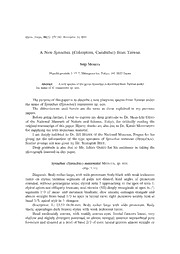
A New Synuchus (Coleoptera, Carabidae) from Taiwan PDF
Preview A New Synuchus (Coleoptera, Carabidae) from Taiwan
Elytra,Tokyo,38(2):279!283,November13,2010 A New Synuchus (Coleoptera, Carabidae) from Taiwan Seiji MORITA Higashi-gotanda5!19!7,Shinagawa-ku,Tokyo,141!0022Japan Abstract AnewspeciesofthegenusSynuchusisdescribedfromTaiwanunder thenameofS.masumotoisp.nov. ThepurposeofthispaperistodescribeanewplatyninespeciesfromTaiwanunder the name of Synuchus (Synuchus) masumotoi sp. nov. The abbreviations used herein are the same as those explained in my previous papers. Before going further, I wish to express my deep gratitude to Dr. Shun-Ichi U´:CD of the National Museum of Nature and Science, Tokyo, for critically reading the originalmanuscriptofthispaper.HeartythanksarealsoduetoDr.KimioM6HJBDID for supplying me with important material. I am deeply indebted to Dr. Jˇirÿı H´6?:@ of the National Museum, Prague for his giving me the information of the type specimen of Synuchus testaceus (J:9A>ˇ8@6). Similar prompt aid was given by Dr. Svatopluk Bÿ>A´N. Deep gratitude is also due to Mr. Ichiro OH=>D for his assistance in taking the photograph inserted in this paper. Synuchus (Synuchus) masumotoi MDG>I6, sp. nov. (Figs.1!11) Diagnosis.Bodyratherlarge,withwidepronotum;bodyblackwithweakiridescent lustre on elytra; terminal segments of palpi not dilated; hind angles of pronotum rounded, without postangular setae; elytral stria 7 approaching to the apex of stria 1; elytralapicesnotobliquelytruncate;analsternite(VI)deeplyemarginateatapexin!; segments 1!3 of meso- and metatarsi bisulcate; claw serrate; aedeagus elongate and almost straight from basal 1/3 to apex in lateral view; right paramere weakly bent at basal 3/5; apical styli in " elongate. Description. L: 13.57!14.86mm. Body rather large with wide pronotum. Body black; appendages dark brown; elytra with weak iridescent lustre. Head moderately convex, with weakly convex eyes; frontal furrows linear, very shallow and slightly divergent posteriad, or almost vestigial; anterior supraorbital pore foveolate and situated at a level of basal 2/3 of eyes; lateral grooves almost straight or 280 SeijiMDG>I6 Fig.1. Synuchus(Synuchus)masumotoiMDG>I6,sp.nov. weaklycurvedalongtheeyes,andbecomingshallowerposteriad;posteriorsupraorbital poresituatedalittlebehindtheposteyelevel;microsculptureconsistingofisodiametric meshes on frons, and of wide to transverse meshes on neck; genae variable in size, but always well convex; GL/eL 0.45, 0.65 in 2 !!; mentum tooth rather wide and weakly bifid at the tip; apex of labrum weakly emarginate; terminal segment of labial palpus cylindrical and widest at about middle (not dilated); terminal segment of maxillary palpus widest at about middle; antennal segment 2 with a long seta; relative lengths of antennal segments as follows:! I:II:III:IV:V:VI:XI!1:0.59:1.25:1.33: 1.39:1.37:1.23 in ", ! 1:0.55:1.20:1.25:1.26:1.22:1.14 in !. Pronotumlarge,weaklyconvexandwidestataboutapical3/8"2/5;PW/HW1.62 in ", 1.56"1.62 (M 1.59) in 3 !!; PW/PL 1.15 in ", 1.04"1.09 (M 1.07) in 3 !!; PW/PA1.43in", 1.42"1.48 (M 1.44) in 3 !!; sides widely arcuate in front and very weakly so from basal third to hind angles; apical angles strongly produced and simply rounded at the tips; apex almost straight at middle and very weakly emarginate or almostobliqueatthesides;medianlinefinelyimpressed,notreachingapexnorbase,and NewSynuchusfromTaiwan 281 Figs.2!11. Synuchus (Synuchus) masumotoi MDG>I6, sp. nov. "" 2, Left side of pronotum; 3, basal part of left elytron; 4, apical part of left elytron; 5, apical part of anal sternite in !; 6, genital segment, ventral view; 7, aedeagus, left lateral view; 8, aedeagus, dorsal view; 9, right paramere, left lateral view; 10, left paramere, left lateral view; 11, apical styli in female. ""P: meeting point between basal border and scutellar striole. Scale: A, 1mm for 5, 7!10; 2mm for 2!4,6;B,0.2mmfor11. 282 SeijiMDG>I6 slightlywideninganddeepeningnearbase;anteriormarginalsetaesituatedatthewidest partoralittlebeforethatlevel,alittledistantfromthemargin,andwithfoveolateroots; anterior transverse impression vestigial; basal foveae rather deep, narrow and smooth; hindanglesrounded,withoutpostangularsetae;basalpart with very shallow longitudi- nal wrinkles at the median part; base briefly bordered on each side; microsculpture consisting of fine transverse meshes. Elytraelongateandmoderatelyconvex;EW/PW1.29in!,1.26!1.33(M1.29)in 3 ""; EL/EW 1.72 in !, 1.62!1.72 (M 1.66) in 3 ""; shoulders completely e#aced; sidesweaklyarcuatethroughout,withnopreapicalemargination;apicesratherrounded (not obliquely truncate); striae deep and weakly crenulate; scutellar striole rather long and situated on interval I; basal pore usually situated at the base of striae 1, rarely on intervalIandclosetobaseof stria 1; meeting point between basal border and scutellar striole deeply concave on each side; microsculpture very weakly impressed and com- posed of fine transverse lines; intervals moderately convex and impunctate; marginal seriesofumbilicatepores19!21innumber;twodorsalporessituatedonintervalIIIand adjoining stria 2 or on the interval; the first pore situated at about basal 1/3!3/7 of elytra, the second one at a little behind the middle to basal 3/4; striae 1 and 2 clearly impressed throughout; stria 7 approaching to the apex of stria 1; apices of striae 3 and 4anastomosedatalittlebeforetheelytralapices;elytralepipleurongraduallynarrowed apicad; inner plica indistinct. Ventralsurfacealmostsmooth;analsternite (VI) deeply emarginate at apex in !, narrowly arcuate in ". Legslongandslender;metatrochanterveryshort,withroundedapex;segments1!3 of meso- and metatarsi bisulcate; segment 4 of metatarsi with two minute setae on dorso-apical part; claw segments of meso- and metatarsi with several setae on ventral side; claw serrate. Genital segment elongated ovate, with short and wide handle. Aedeagus elongate, moderately arcuate at basal third and almost straight from basal 1/3 to apex in lateral view; viewed dorsally, apical part very weakly curved towardstheright, and with simply rounded apex. Right paramere weakly bent at basal 3/5,withsimplyroundedapex;leftparameretriangular.Apicalstyliin"elongate,with two robust spines. Type series. Holotype: !, Mt. Tahanshanm, Pingtung Hsien, 13!III!2003, K. Masumotoleg.Paratypes:1",Liukei,KaohsiungHsien,18!XI!1984,nativecollector; 3"", Mt. Tahanshanm, Pingtung Hsien, 13!III!2003, K. Masumoto leg. Range. Taiwan. Notes. According to the key given by L>C9GDI= (1956, p.494), this species is similar in structure of hind angle of pronotum and meso- and metatarsi to Synuchus testaceus J:9A>ˇ8@6 (1940, p.4), but mainly di#ers from the latter in the larger body, wider pronotum and almost straight aedeagus. NewSynuchusfromTaiwan 283 ! " !"#$% &’()*+,-./012Synuchus 34567589:01;< =1>?@ !! ABCDEFGHIJ&’KLMNOP)*+,-./01SynuchusQR >?STUVJWX VS.masumotoiSYZVP@ [=?\R ]^KR _‘abcdeSfghQij[SR D=kl mnlopqrVR so1/3tunlvKvIwxUyzU{=|}Q~(cid:127)@ References J:9A>ˇ8@6, A., 1940. Neue Carabiden aus Ostasien. (haupts¨achlich von der Insel Formosa.) (XIII. Teil.). Praha:A.J:9A>ˇ8@6,18pp. H67J,A.,1978a.Carabidae:Platynini(Insecta:Coleoptera).FaunaJaponica.viii(cid:128)447pp.,36pls.Keigaku Publ.,Tokyo. !!!!1978b.NotesanddescriptionofFormosanCarabidaetakenbyDr.S.-I.U´:CDin1961(Coleoptera, Carabidae)VIII.Synuchusspp.Ent.Rev.Japan,Osaka,31:33"67. L>C9GDI=,C.H.,1956. ArevisionofthegenusSynuchusGNAA:C=6A(Coleoptera:Carabidae)inthewidest sense,withnotesofPristosiaMDIH8=JAH@N(EucalathusB6I:H)andCalathusBDC:AA>.Trans.r.ent. Soc.London,108:485"585.
